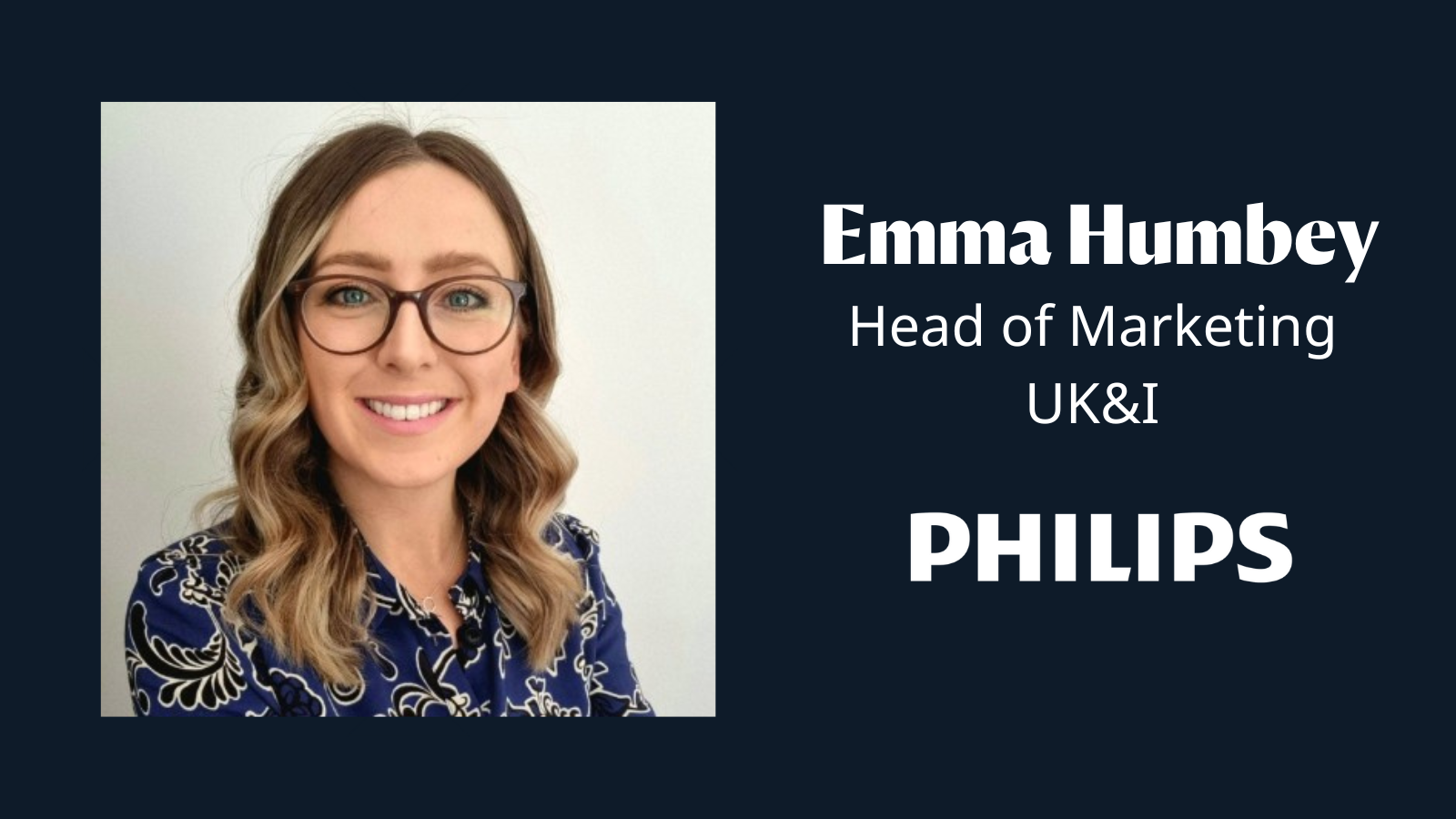
Q. Tell me about your current role at Philips and your focus?
Due to the sales cycle of the Health Systems business, historically there has been a bigger focus on more traditional, offline channels - events, general sales support, etc. So, my role is very much about showing the value that digital can bring to the organisation and using it to support the core business needs, making a bigger impact.
One of the biggest challenges, however, like many B2B and D2B businesses, is showing the return on investment. On the consumer side, it is so easy to implement a new digital campaign, press the button, and the next day, you see your results. When you put more money in the top, you’ll achieve even better results.
With a B2B sales cycle, especially when we’re talking big equipment such as MRI and CT scanners, there’s a long sales cycle – in some cases more than 18 months. So, a lot of where I see digital adding value is through influencing at certain points in the sales cycle, through awareness, education and not forgetting post-sale loyalty.
But to do this, I’ve had to spend time educating my colleagues and the wider organisation on why digital is important and why it needs investment. Often without being able to show: (a) an immediate return on investment, and (b) any clear return on investment even after 18 months. This can’t be done quickly, and I’m relying on broader metrics such as reach, engagement and micro-conversions.
You're educating people that often don’t use social media themselves, so it’s not easy explaining, "Right, if we put this money in, this is who we can target, this is how often we can target them, therefore we get that constant engagement." Quite often I’m met with push-back around the sales cycle and that for those big-ticket items customers still engage directly with the sales team to complete the purchase.
What I’m trying to prove is how we’re supporting them, creating additional touch-points, and often educating customers before they contact the salesperson to initiate the purchase. For example, through webinars or interactive content on our website.
This is the biggest part of my role at the moment - trying to educate and get people understanding digital.
In the five years I've been at Philips, we have made so much progress within this area. We’re utilising digital channels directly, driving employee advocacy campaigns, and growing our D2B e-commerce channels.
My vision has always been to drive a truly connected marketing team, integrated with the sales organisation, and for us to have a seat at the table when discussing business strategy. I currently sit alongside the sales and business leaders within the leadership team, and we’re starting to have joint conversations on how we invest our budgets and where our priorities are.
Q. Where is Philips in its thinking with digital transformation and being agile?
I believe we’re an organisation with the drive and the skills to be more agile, to create the right customer touch-points, and even start to automate some of the activity we're doing throughout the life-cycle. However, within such a large organisation, these things take time to fully implement.
The UK and Ireland region is one tiny part of a global organisation. Which means we have different regional needs, and therefore a lot of different systems. So, from a system point of view, things don’t always talk to each other – this is a journey. For true marketing automation we need the sales system to talk to the marketing platforms to link to the customer service database. And historically these sit in silo as they were needed.
A good example is from when we launched our e-commerce D2B platform. We have this great ambition as an organisation to drive simplicity and ease for our customers. But due to different systems, it took time to make sure the pricing system connected to the e-commerce platform and that the data is clean and up to date. Then we needed to ensure this linked to Salesforce as well as our marketing platforms. The ambition we had and the buy-in from the leadership teams helped us push this through, but the speed of making changes like this is often long.
Interviewer: Our Digital Transformation survey results were really puzzling at first, and we couldn't work out what was going on, because people seemed to think they were digitally mature, but then when you asked them specific questions, they weren't doing the things that you would consider to be indicators of digital maturity. They were still automating. I think that's where we got to - it's sort of the top and the bottom understand what needs to happen. The Board know what needs to happen and the people there at the front line know what needs to happen, but there's a whole stack of stuff in the middle. I saw a guy called it a syrup sandwich where everything just gets stuck.
Q. Do you still think in terms of digital transformation? Is it still a term that has meaning at Philips?
I don't think we really use that term anymore, within Philips or among my marketing peers. I personally feel we spoke about this a lot five years ago and since then we have made progress. But we're still on the journey, as you’re right, there are sticking points.
If you think of that conversation we have with top layer, for example, the senior leadership team, they see us being already transformed digitally because we're doing things that we didn't do five years ago. But when I discuss with my peers, we still feel there is so much more to do. It's almost like a new term maybe is needed because we have transformed, but we’ll always be on this journey.
One thing I do talk a lot about, and continue to have these conversations internally, is about ‘transformation’ and making that customer-first transformation. It’s a transformation to be better for the customer, help the customer more, that customer-first mind-set.
So, whilst I don’t believe digital transformation means anything anymore, there is still transformation needed. We need to perhaps come up with a new buzzword of what we should be aiming for next.
Q. What does the Board think of, or what do your Senior Management that you talk to, see as the benefits of digital?
Interviewer: Do they think about very obvious business benefits such as, revenues, increased revenues, reduced costs, greater efficiencies? When you're thinking about, as you said, a customer-first approach, are there different metrics applied at a senior level to say, "Yes, we want to be more customer-centric and we'll measure it by whatever”?
We talked a lot about how customer-centricity is a key to being a successful company.
So, how can we include this within our more operational discussions, and integrate it into our performance KPIs? An example of this is our mission statement… We aim to improve 2.5 billion lives per year by 2030, including 400 million in underserved communities.
This focus overarches all we do, and is tracked alongside our financial results. That’s the conversation that happens at ExCo globally, as well as on a local regional level. This customer-first focus enables us to prioritise our activity and then have that focused discussion around ROI and growth on an operational level.
Q. What are the challenges that you face on the journey to transformation? Cultural, technological, organisational, structural - where are the real friction points?
I think the biggest one is probably that organisational/structural piece. We have ambitions, but we are a global organisation where moving fast isn’t easy.
At Philips, we have a culture of test and learn, helping us to pilot and experiment, but deploying something at scale takes time.
Before Philips, I worked at much smaller companies, and whist there was the benefit of speed, there was often a lack of budget and support. Whereas in a large organisation it may take time, but the impact is often greater and more focused.
I also see a personal challenge on balancing the day-to-day operational performance whilst also driving change and improvements. I’m continuously looking for ways we can improve the efficiency of those day-to-day activities to give us more time to focus on new channels or innovative projects. I feel this has helped push marketing more into the organisation, by simplifying what we do whilst still focusing on the future.
Q. How much of that do you think is an issue of old-fashioned attitudes to marketing rather than old-fashioned attitudes to digital?
Hmm, good question. I think this is extremely relatable to B2B/D2B organisations, especially within more traditional industries such as healthcare where we work a lot with the NHS.
Unlike B2C/D2C organisations, where it is a consumer-driven behaviour to want to be able to purchase quickly from their own wallets, wherever they are, and have generally high expectations of digital services. Thank you, Amazon! On the flip side, where there are government or corporate budgets, and products which require significant investment, there is a need for direct sales activities, sales people on the ground to engage directly with customers throughout the purchase journey.
Presentations, product reviews, tenders, site visits, etc - these cannot be done digitally.
I wouldn’t call this an old-fashioned view, because I believe it’s still relevant, but it’s more about the value-add digital can bring, and how it can build on and support the already-strong sales teams to sell more, sell quicker, and gain more customer loyalty.
On another note, I think it’s fascinating that a lot of the younger generations within healthcare are more digitally-led. I see doctors on TikTok with huge followings. So, whilst we cannot use social media to sell an MRI Machine, we can certainly engage with these healthcare professionals at a much earlier stage in the sales cycle and create brand preference. That’s where I want marketing to make an impact.
Interviewer: One of the other things you mentioned earlier, and it's something that I find myself coming back to a lot in interviews, is the question of measurement. Obviously, we talked about measuring over sales cycles and how difficult that is.
Q. When you've got digital initiatives, how are you measuring them? How are you relaying what they're achieving back to a non-marketing or a marketing sceptic, digital, unsavvy audience?
I think this is a challenge all round. As, whilst we have our marketing metrics, they don’t often tie into business metrics. For e-commerce, for example, it’s easier to focus on revenue or efficiency savings, e.g. if you’re moving an offline business online, we can quite quickly translate hours saved from sales teams into a financial measurement that leadership can understand. As well as revenue growth from upselling/cross-selling.
However from a digital marketing point of view, everything we communicate outwards, we have to choose success measures that people understand and can relate straight to the business. They have to be commercially driven.
Whilst we marketers may talk about engagement, conversion rate, etc, we need to make these metrics tangible for non-marketing and leadership teams. We must explain things more simply. Like… this is how many people we drove to sign up to this event where we generated X number of leads and therefore X number of business opportunities.
I like to keep things simple and use metrics that are tangible, that anyone can understand. It's still very tricky, because we've got so many different touch-points. And, as you know, different channels track different measurements (video views vs. reach vs. engagement) But, I like to try and build that commercial story to show the impact.
Interviewer: I'd be interested in talking a bit more about this e-commerce project, because one of the things that's really nice when you're doing these sorts of reports is to have concrete examples of things that people have done, and particularly what the challenges were, how they were overcome, just so that other people reading it can go, “Oh, right. Wow.”
Q. Can you talk a bit more the Philips e-commerce project?
Within the healthcare space, Philips sells everything from small medical consumables (blood pressure cuffs, sensors to monitor oxygen levels, for example), through to mid-sized equipment (AEDs, ultrasound machines), and all the way up to MRI and CT scanners, as well as a broad range of informatics technology.
So, whilst we knew we couldn’t sell our main equipment though e-commerce, there was an opportunity to sell the smaller, fast-flow products.
Customers would usually email an account manager to check pricing and stock levels, and to place the order. But, due to the nature of these products, we knew we could make things much easier for the customer by following the consumer model and make all this information and order capability available online.
We know hospitals are open 24/7, and often things are needed quickly. But also, all the information that the customer needed (pricing/stock) was set on these products, no customisation or special quoting required - which made this the perfect opportunity to streamline our order flow, saving our customers time and effort, allowing them to self-serve when they needed it, and freeing up our sales teams to focus on upselling, tenders and new projects.
Now, anyone who has taken an offline order flow and moved it online knows this is more complex than it sounds. From a technology point of view, e-commerce speaks in ones and zeros. Everything has to be black and white. Whatever goes into the system comes out in a certain way. This meant that we spent a large part of the project reviewing and checking all our data points. Pricing, customer accounts, product information etc. This all had to be 100% accurate and stored in connected systems for e-commerce to truly work.
One of the things I’m personally most proud of on this project is how it brought together various teams across the organisation. I worked with pricing teams, supply chain, product management, and sales. Which shows how marketing really can influence an organisation.
And so, it became a much larger transformational project than initially expected, because it didn't just impact one team, one customer, it's impacted everyone. Now, we're still on that journey, but it's definitely had a big role in educating the different business units and the different functions on why it's so important to be set up to automate things successfully.
Interviewer: That's really interesting, because everybody talks about small scale projects, quick wins, but if you happen to pick one that's absolutely almost by accident, completely culturally transformative, yeah, wow. That's grabbing the tiger by the tail, isn't it?
Exactly. Even just from a cultural point of view, the amount of conversations that I was involved in with senior management asking, "Why are you trying to change everything?" and trying to then change their mind-set and educate them, saying, "Actually, but if we do this, if you empower your teams and give the them this priority, this is how much we can save, and this is how much we can grow our business from a new customer point of view."
I had to learn a lot about influencing stakeholders, and in fact I would rate this as one of the most important aspects of any transformational programme. Understand the business strategy, relate your ambitions to it, and then share and promote with leadership.
Interviewer: This feeds directly into the next question which is about giving people confidence to invest in digital projects.
Q. Is it always more money, lower cost? Is that always what people are looking for?
I think right now, yes, right? The business pressures are on across the board, like economically, it's been the hardest few years.
If you look externally in the news, companies across the board are cutting costs, saving where they can, and I think if you can focus on that or create a project that supports that, you're definitely going to get easier buy-in and easier support, as long as it delivers and it meets the expectations that are set at the start.
I think it’s a balance between customer-first and cost-first and what will have the most impact.
Q. Is there a role for brand or rather, clearly there is a role for brand, how big is the role for brand in what you do? How important is brand?
Yes, absolutely. Brand plays such an important role in ensuring our presence is consistent, and we ensure our customers have that brand preference, loyalty and understanding when they come to purchase. And when we introduce digital touch-points into the journey, brand becomes even more important to retain that consistency.
Interviewer: Emma, thank you so much for sharing the Philips digital transformation journey, and your own story with us. I'm sure our readers will gain a lot of insight!



